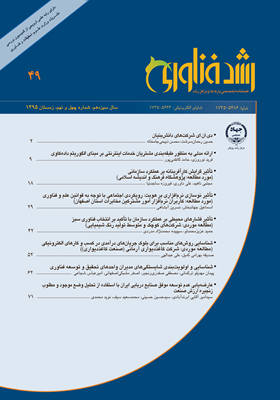شناسائی روش های مناسب برای بلوک جریان های درآمدی در کسب و کارهای الکترونیکی (مطالعه موردی: شرکت کاغذ دیواری آرمانی (صنعت کاغذدیواری))
محورهای موضوعی :صديقه بهرامي کميل 1 , علی عبدالهی 2
1 - دانشگاه ارشاد دماوند
2 - دانشگاه شهید بهشتی
کلید واژه: مدل کسب و کار مدل کسب و کار الکترونیکی جریان های درآمدی ساختار هزینه,
چکیده مقاله :
امروزه کسب و کارها با محیطی چالش برانگیز و همواره در حال تغییر روبه رو هستند، تجارت و روش های کسب و کار، یکی از مهمترین حوزه هایی است که با به کارگیری فناوری های اطلاعاتی به شدت تحت تاثیر قرار گرفته است، بسیاری از روش های کسب درآمد متحول گشته و روش ها و ارزش های جدید فراوانی پا به عرصه وجود نهادند. مدلهای کسب و کارِ شرکتها یکی از عوامل اصلی در میزان موفقیت عملکرد آنها و در واقع چارچوبی برای کسب درآمد هستند، به سه پرسش کلیدی پاسخ میدهند، کدام فعالیتها، چگونه و چه وقت باید انجام شوند؟ پاسخ صحیح به این پرسشها منجر به عملکرد مناسب و ارائه مزایای مطلوب به مشتریان و در نهایت سود برای شرکت می شود. اگر مشتریان قلب مدل کسب و کار باشند، جریان های درآمدی شریان های آن را تشکیل می دهند. شرکت باید از خود بپرسد که هر بخش مشتری واقعا برای چه ارزشی تمایل به پرداخت پول دارد؟ از این رو هدف اصلی مقاله، شناسائی روش های مناسب برای بلوک درآمدی در کسب و کار الکترونیکی در صنعت کاغذ دیواری برای شرکت آرمانی می باشد. چارچوب تئوریک تحقیق بر مبنای مدل استروالدر ترتیب داده می شود. جامعه آماری در این تحقیق مدیران ارشد، پرسنل واحدهای مالی، بازاریابی و فروش شرکت آرمانی می باشد. سپس از طریق مصاحبه نیمه ساختار یافته و با استفاده از تحلیل محتوا از نوع تحلیل تم سعی شد تا مولفه های اصلی جریان های درآمدی و هزینه مدل کسب و کار الکترونیک استخراج گردد.
Today's business environment is challenging and constantly changing face, trade and business, one of the most important areas that the adoption of information technologies is severely affected, many methods Earn evolved and new methods and frequency values into being established. Business Models Companies a major factor in the success of their performance and the framework to earn money, to three key questions answered are, what activities, how and when to be done? The correct answer to these questions lead to good performance and provide optimal benefits to customers and ultimately profits for the company. If customers are the heart of business models, revenue streams that make up arteries. Companies need to ask themselves what value each customer segment really willing to pay for it? The main purpose of this paper is to identify appropriate methods to block e-business revenues in the industry are ideal for wallpaper. Research based on the theoretical framework given Astrvaldr model. The population in this study, senior managers, personnel of financial, marketing and sales is ideal. Then through semi-structured interviews and analyzed using content analysis Subject to the main component of revenue streams and cost of e-business model can be extracted
1- سایت گمرک جمهوری اسلامی ایران (www.irica.gov.ir).
2- منطقی، منوچهر؛ ثاقبی سعیدی، فاطمه (1392). مدلهای کسب و کار؛ مبانی، ارزیابی، نوآوری، فصلنامه تخصصی رشد فناوری.
3- Teece, D. (2010). Business Models, Business strategy and Innovation, LRP Long range planning, Vol.43. pp:172-194.
4- Osterwalder, A. & Pigneur, Y. (2012), An Ontology for e-business models. In Currie, W. (Ed), Value Creation from e-business from e-business Models, Butterworth Heinemann, Oxford, pp: 65-97.
5- Kujala, T. Artto, K. (2013). A framework for performance measurement in the ebusiness environment. "Electronic Commerce Research and Applications". pp: 395-412.
6- Chesbrough, H. (2010). Business model innovation: Opportunities and barriers. Long Range Planning, 43, pp: 354-363.
7- Leitao, A. Cunha, P. Valente, F. Marques, P. (2013). Roadmap for business models definition in manufacturing companies. Forty Sixth CIRP Conference on Manufacturing Systems, Vol. 7, pp: 383-388.
8- El Sawy, O.A., Pereira, F. (2013) Business Modelling in the Dynamic Digital Space: An Ecosystem Approach, Springer.
9- Mishra, A. (2013). Business model for Indian retail sector: The Cafe Coffee. Day case In conversation with V.G. Siddhartha, Chairman, Coffee Day. IIMB Management Review, Vol.25 (3), pp: 160-170.
10- Moingeon, B. Lehmann-Ortega, L. (2010), Creation and Implementation of a new Model: a disarming Case Study, Journal of M@n@gment, Vol. 13, No 4, pp: 266-297.
11- Osterwalder, A. & Pigneur, Y. (2010). Business model generation, Published by John Wiley & Sons, Inc., Hoboken, New Jersey. ISBN: pp: 112-114.


